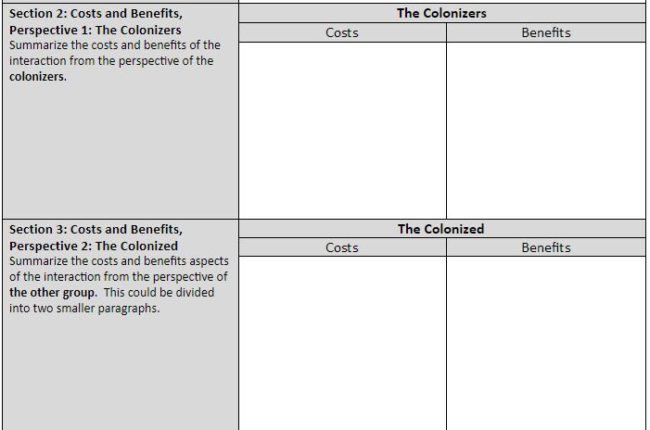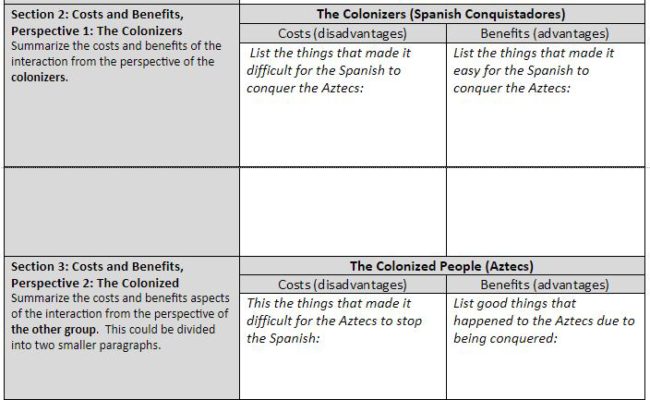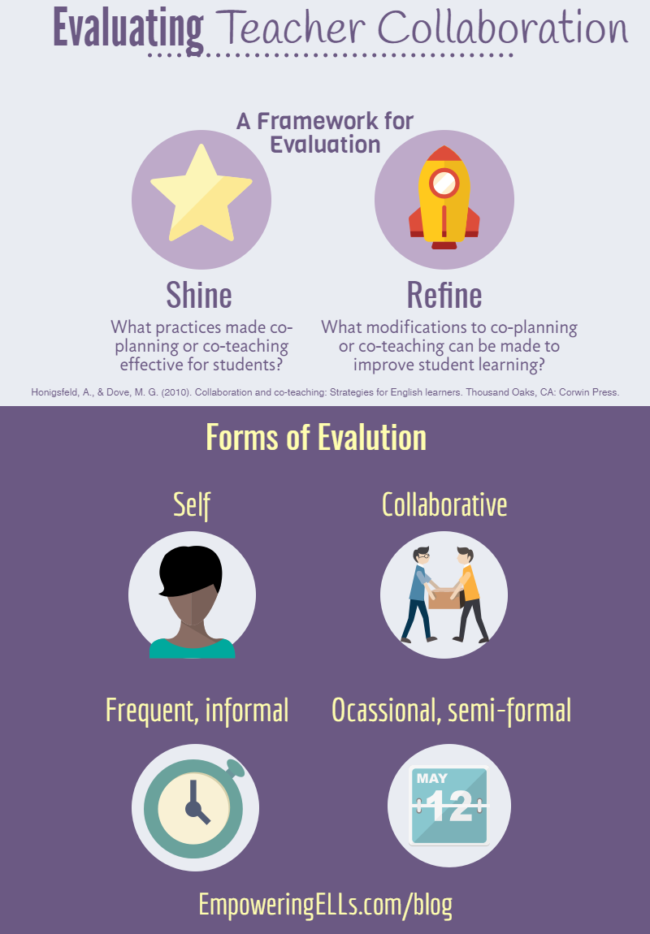This article on evaluating collaboration is Part 12 of the Collaboration for ELLs Series.
At the end of each school year, I have a formal evaluation with my principal. To prepare for last year’s meeting, I voluntarily surveyed the content teachers with whom I co-plan instruction, collected the data, and shared it with my principal. My principal said that surveying my teacher collaboration was an act of bravery. Though humbled, I didn’t really understand how can asking people for feedback could be an act of bravery? I just wanted to improve my practice.
I’ll describe the different forms of evaluations and offer some practical strategies written especially for those of you who find the prospect of evaluations particularly daunting.
Establishing a Framework: Shine-Refine
In Andrea Honigsfeld and Maria Dove’s book entitled Collaboration and Co-Teaching: Strategies for English Language Learners (2010), they suggest that creating a framework for self-evaluation facilitates reflection in a non-judgemental way.
In Shine-Refine, you reflect on what went well during the collaboration and determine what needs improving. This framework is free of value judgments because it doesn’t have areas that as assign blame, such “Who did what?” or “Why was this done?”. The Shine-Refine approach focuses only on the positives and how to make improvements.
Shine-Refine is versatile enough to be used with all aspects of collaboration including co-planning, co-teaching, and co-assessing. Try setting up a spreadsheet in Google Sheets to keep track of your notes and easily share them with your colleagues to foster more collaboration.
Keep in mind: you don’t have to use the Shine-Refine framework. It’s more like a compass than a map in terms of evaluating your collaborative practices. It’s a guide to gain your bearings, not tell you which way to go.
What’s most important is creating a framework that structures your reflection. Without a framework, there’s the risk of feelings being hurt and relationships being strained – resulting in stalled collaboration.
Ways to Evaluate Teacher Collaboration
Frequent, Informal
In frequent, information evaluations, the English language teacher (ELT) frequently takes time to consider what went well and what needs improving. The reflection is done consistently and within short intervals such as:
- weekly
- at the end of a learning experience
- after an assessment has been given
This form of evaluation is the most effective because it’s ongoing, and it lets you provide the most amount of feedback. You can use the Shine-Refine framework as a log or journal to help you reflect on your practices.
Usually, there’s no paperwork involved in frequent, informal evaluations. They’re just simple, casual conversations. For example, during a co-planning session with Mr. D, a history teacher, I introduced Buncee and Piktochart as software programs that students can use to express their ideas. After the first week of engaging with the programs, I asked Mr. D if he liked the idea of using them as alternative assessments in place of traditional posters and essays.
Occasional, Semi-Formal
This form of evaluation occurs periodically:
- after a unit of learning, or
- at the end of a quarter or semester
I prefer assessing collaboration at the end of units because it’s a nice bookend to a sequence of connected learning experiences. My content teachers and I usually reflect on how to improve the unit for next year, and, since we’re already together, I use these times to informally evaluate the collaboration. A scheduled meeting makes this reflection somewhat formal; however, it’s not a performance evaluation.
In one instance, I noticed that most of the ELs were confused by the wording in a particular part of a graphic organizer designed to help them complete a history assessment in Mr. D’s class. When he and I met to reflect on the unit, I suggested using a modified scaffold the next time we teach the unit.

Unmodified assessment

Modified history assessment
Self-Evaluation
Regardless of if you use Frequent or Occasional evaluation, you have consider if you will self-reflect or do it collaboratively. Self reflection is appropriate if your teaching partner is not particularly keen on evaluating your collaboration. Not everybody is. However, you can still reflect by yourself using the Shine-Refine framework.
As an alternative, you can go through the evaluation by yourself and then share it with your co-teacher. They don’t have to go through the process, but there still can be a conversation based on your self-evaluation.
If your co-teacher doesn’t share your enthusiasm for evaluation, you can instead practice one of the most effective professional development techniques – record yourself co-teaching or co-planning and view it afterwards to look for effective and ineffective practices. Hattie suggests that recording yourself teaching (what he calls micro-teaching) is one of the top 10 most effective teaching practices available to educators (2009).
The frequency and the immediate feedback of micro-teaching can, in turn, create micro-shifts in one’s teaching and positively impact student achievement. I know of no other practice that has transformed my practice as much as micro-teaching. My tip is to set a micro-goal to focus your evaluation of your video. Don’t try to change everything all at once. Make micro-changes, which will produce significant changes overtime.
Here’s an article from Edutopia entitled “Record Yourself to Improve Practice” that goes further into the benefits of micro-teaching.
Collaborative Evaluation
The final form of evaluation is highly effective because it’s a joint venture in improvement. Both teachers are committed to growth. The benefits are tremendous because you have another person’s perspective, and they often identify things that are not immediately obvious to you.
The goal of collaborative evaluation is for both teachers to offer feedback to one another regarding their partnership. You can use the Shine-Refine framework to keep your focus on improving actions rather than on placing blame or offering criticism. This form of evaluation lends itself to a celebration of the partnership because both teachers should ideally be identifying things that made the collaboration effective.
I practice a modified version of collaborative evaluation using a Google Form survey. I send this survey out to the content teachers that I collaborate with at the end of the semester or year. While the survey is anonymous, I invite the teachers to have a conversation if the content teacher is open to it. Several teachers have responded and we have had helpful conversations about my practice that have have influenced my practice greatly.
If you’re interested in even more evaluation techniques, I encourage you to survey your students as well. To learn more, read 5 Reasons You Should Seek Your OWN Student Feedback by Jennifer Gonzalez.
Takeaways
We often ask students to engage in self-evaluation, and they undergo a barrage of formative and summative evaluations from us. However, when do we evaluate ourselves and our practice?
If you already do, then great! Take your evaluation to the next-level by reflecting on your collaborative practices. I have offered four different forms of evaluation that can be combined to fit your context. The form of evaluation is not important as the act itself. Your teaching, your partnership, and your students’ achievement will all reap the benefits of your conscientious evaluation.


